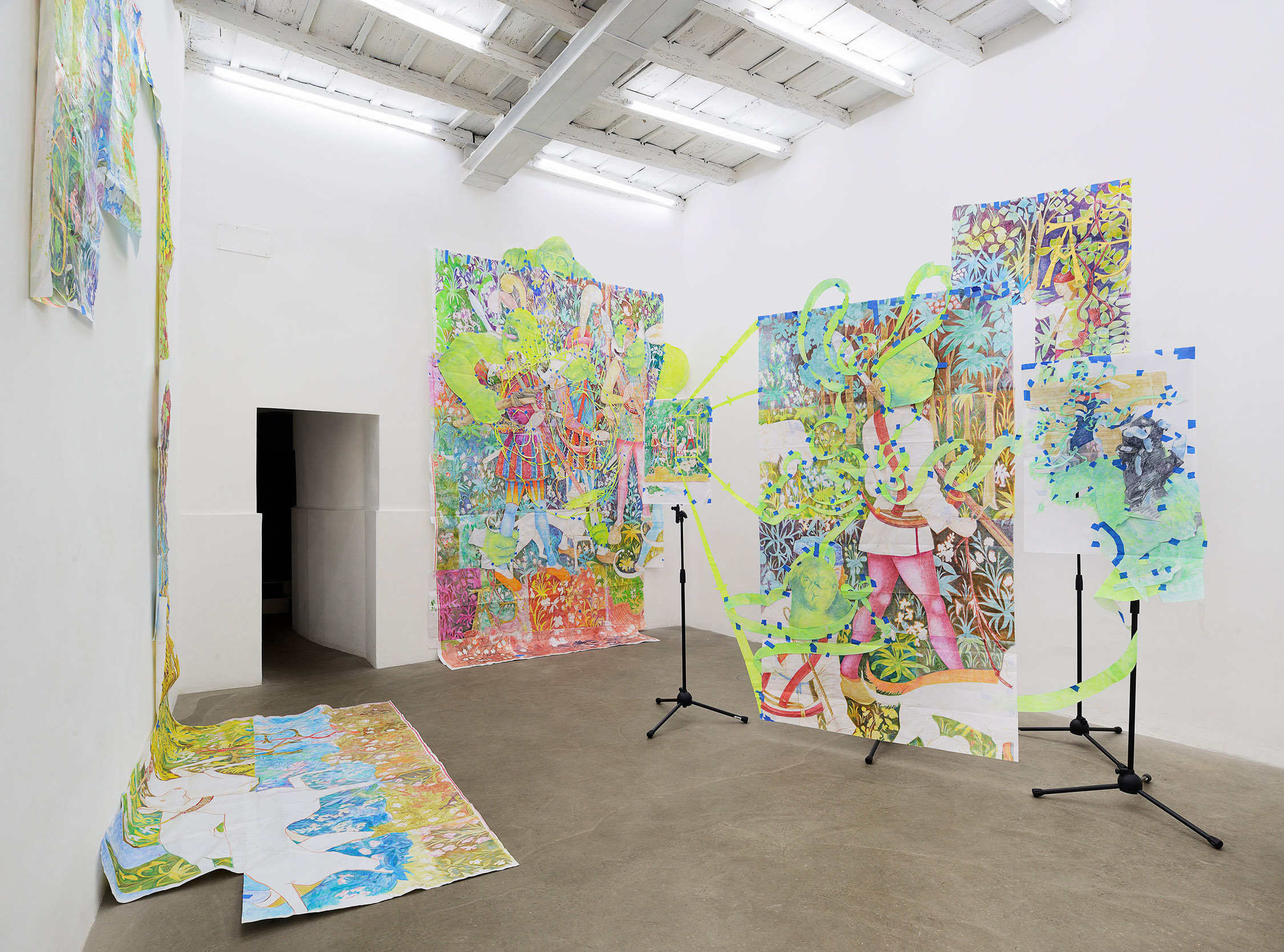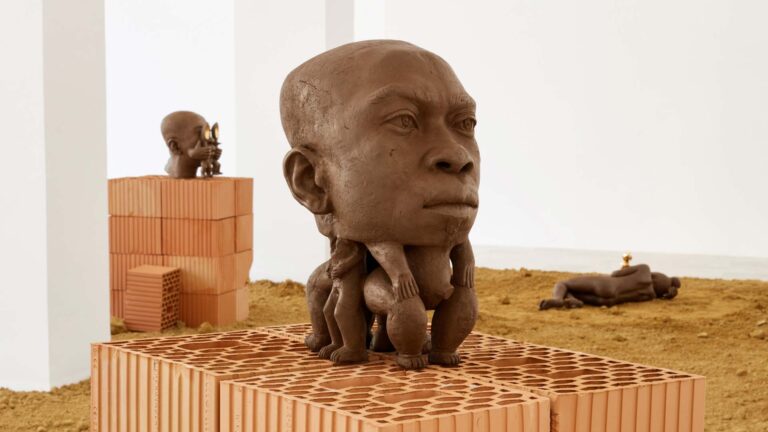This is not the whole story. The Hunters Enter the Woods is one of The Unicorn Tapestries, seven early modern Flemish tapestries currently in the collection of The Metropolitan Museum in
New York. The Met places The Hunters Enter the Woods as the first in the sequence. But the tapestries are famously shrouded in mystery and speculation; questions remain open about the order of the sequence, whether there are any missing pieces, and whether these seven tapestries ever really constituted a unified set. This isn’t the whole story, clearly. The hunters are not even in the woods yet. The main event of the unicorn, which appears in all the other Unicorn Tapestries, is still out of shot here. We’re at the edge of the forest, and we’re still on the periphery of the heroic narrative of the hunt.
Sam Keogh’s collage installation and performance The Hunters Enter the Woods Cartoon takes the peripheral scene of the hunters entering the woods as a starting point, before cutting to a close-up on the peripheral figures of the page boys. In the original tapestry, these pages have been tasked with guiding and facilitating the noblemen on their unicorn hunt. The noblemen, who appear in fine, colourful garb with elaborate plumage on their hats, are the main characters. This is their hunt. Their story. Their spears and hounds. But the wealthy tell their story as if it’s the whole story, when it isn’t. What happens if the story is told by the minor characters of the pages instead? Follow the gazes of the page boys, and find yourself led outside the edges of the
pictorial frame. The plot wanders off, beyond the familiar framing, as the spectacle of aristocratic heroism is decentered and made peripheral.
As with all large-scale tapestries from this period, The Unicorn Tapestries would have been extremely expensive. Objects like these were commissioned by the wealthy merchant and aristocratic classes – and since it was their money, the pictures had to tell their stories of morality and conquest and grandeur. But The Hunters Enter the Woods Cartoon zooms in on a part of the woven image, to find alternative plot threads that lead beyond its frame. There are always ways
to look at images while looking at the limits of their frameworks. Always ways to digress from the main plot; to puncture its semblance of wholeness, to misread its details, and to follow tangents that lead outside the limits of its frame.
As with other pieces in Keogh’s Unicorn Tapestries Cartoons series, The Hunters Enter the Woods Cartoon explores the form of the preparatory cartoon in the fifteenth and sixteenth centuries. To make pictorial tapestries in this era, artists would start with 1:1 sketches on paper
– preliminary cartoon fragments or “working drawings” that allowed them to figure out the elements of the scene and its overall composition. In the final tapestry, the various image parts have been fixed in place, and flattened into a unified pictorial plane. But through the preliminary phase of the working drawing, Keogh enters into an image ecology of layers and seams and gaps and shifting relations. The parts are still very much parts; they can be moved around and
reassembled, maintaining a sense of disjuncture that also recalls early twentieth-century forms of collage, where found image fragments are brought into new hybrid entities.
Part of the appeal of the collaged image is that it maintains a sense of awkwardness in the relation of the parts to the whole. The stitches in a tapestry are parts brought together to make whole pictures, just as the pixels on my screen are bundled together to form the letters I’m typing… But pixels and tapestry stitches are supposed to add up to a sense of smooth coherence, with the separateness of the tiny parts disappearing into the greater whole. In contrast, Keogh’s collage-based installations bring disparate parts into alternative, busted wholes – in ways that feel provisional and propositional. The seams between the parts are always visible; bits are pieced onto other bits with blue tape that doesn’t try to disappear. Coherence is continually undone, and spaciousness is found within the brokenness.
As the pages from The Hunters Enter the Woods start to wander beyond the picture that frames them, their bodies start to change. Through the propositional incoherence of collage, they acquire the green heads and huge three-fingered hands of Tolkien trolls …
–possibly something to say here on their composite bodies marking what Keogh refers to as a transversing of fantasies, with part of the twentieth-century fantasy genre cut out and pasted into the projected fantasies of the wealthy sixteenth-century tapestry owners?
–Holes: Having stepped outside the frame, the page-trolls are then able to get behind the pictorial plane. In the installation, they are seen climbing up the back of the picture, protruding above it, and puncturing it from behind – opening up new space within the plane, undoing its wholeness with an insistence on a hole-ness that lets other things in.
–& something here on the parallel between moving from the noblemen hunters to the “minor character” pages who facilitate their hunt, and moving from the tapestry to the preparatory (paper) pages that facilitated the tapestry’s execution. The main characters of the wealthy noblemen, like the rarefied objects of their finished tapestries, are not supposed to appear with evidence of the amount of labour required to create and sustain them. The pages are supposed to disappear into the background, never taking centre stage. This background of labour comes to the foreground in The Hunters Enter the Woods Cartoon, where the pages are visibly messed up with marks and folds and tears, which accrue with each iteration of the installation and performance.
–Also want to say something about lushness and pleasure (and craft?). The gorgeousness of the colours? The dizzying scale of Keogh’s collage relates back to the huge expanse of the Unicorn Tapestries – as does the abundance of detail; the fullness of the image. In both cases, one senses the amount of hours that have gone into the making. But through all the attentive absorption and luxurious detail, Keogh keeps things unfinished and scrappy and provisional. So that they might become otherwise
Text by Amelia Groom.
Sam Keogh (1985, Wicklow, Ireland. Lives and works between Glasgow and Co. Wicklow, Ireland) works across sculpture, collage, video, installation and performance. His installations include intricately made sculpture and collage which often act as props, backdrops and visual scripts for performances. Taking the form of fractured monologues, the performances present characters who are pulled apart by their efforts to convey a theory, anecdote or historical event. Here, the work’s physical, gestural and linguistic materials combine to create grubby cognitive maps of interconnecting themes as varied as masculinity, colonialism, science fiction and the politics of popular culture. Sam Keogh received an MFA from Goldsmiths College in 2014 and completed the Rijksakadmie residency in Amsterdam in 2017. His work has been exhibited at Primary, Nottingham: Goldsmiths CCA, London; Museo Madre, Naples; Centre Pompidou, Paris; 15th Lyon Biennial; The Douglas Hyde Gallery, Dublin and Eva International, Limerick.
Amelia Groom is a writer and art historian who has published texts on mud and swamps, on Mariah Carey’s refusal to acknowledge linear time, and on Beverly Buchanan’s ruinous, environmental sculpture Marsh Ruins, among other topics.














